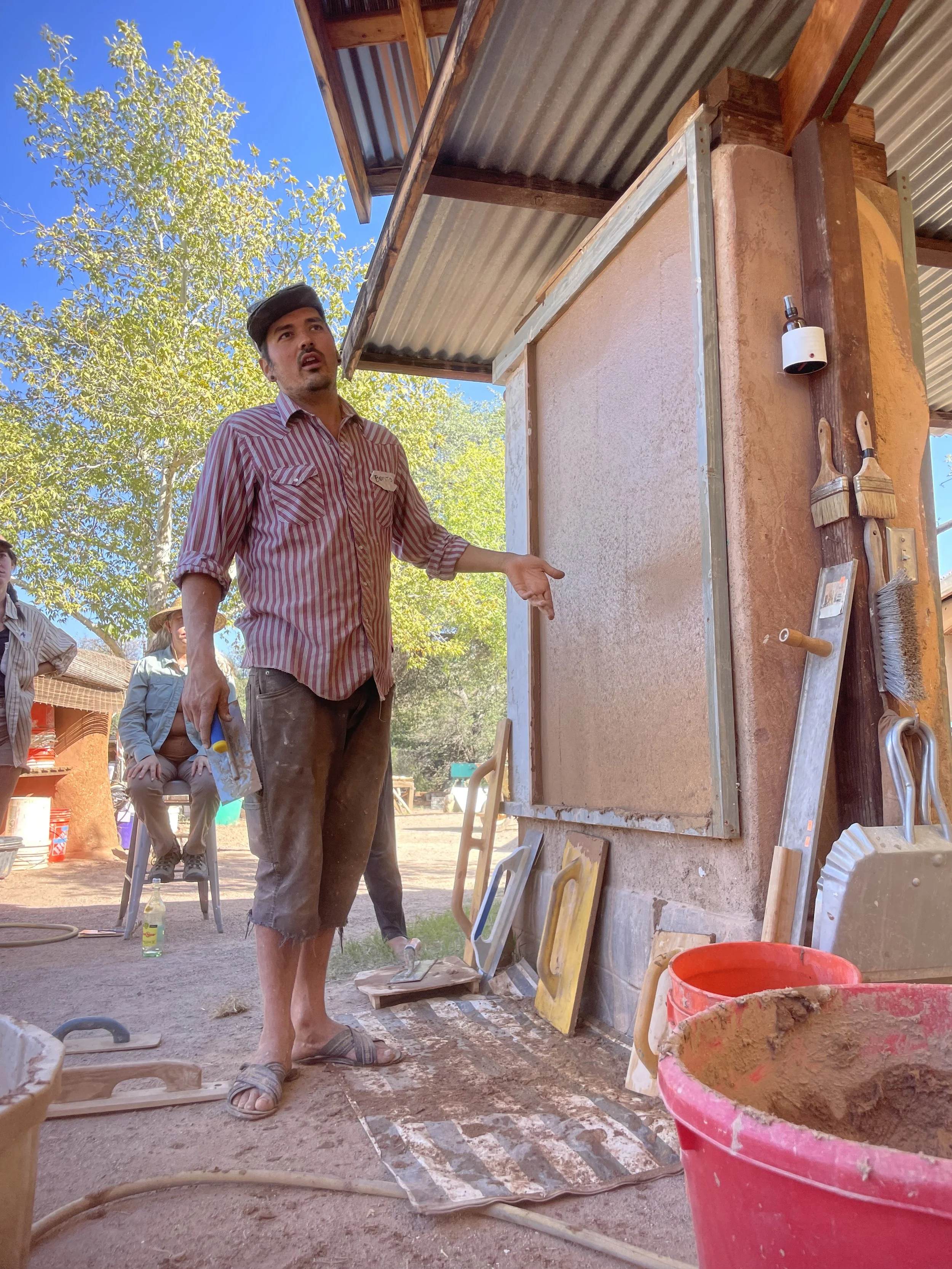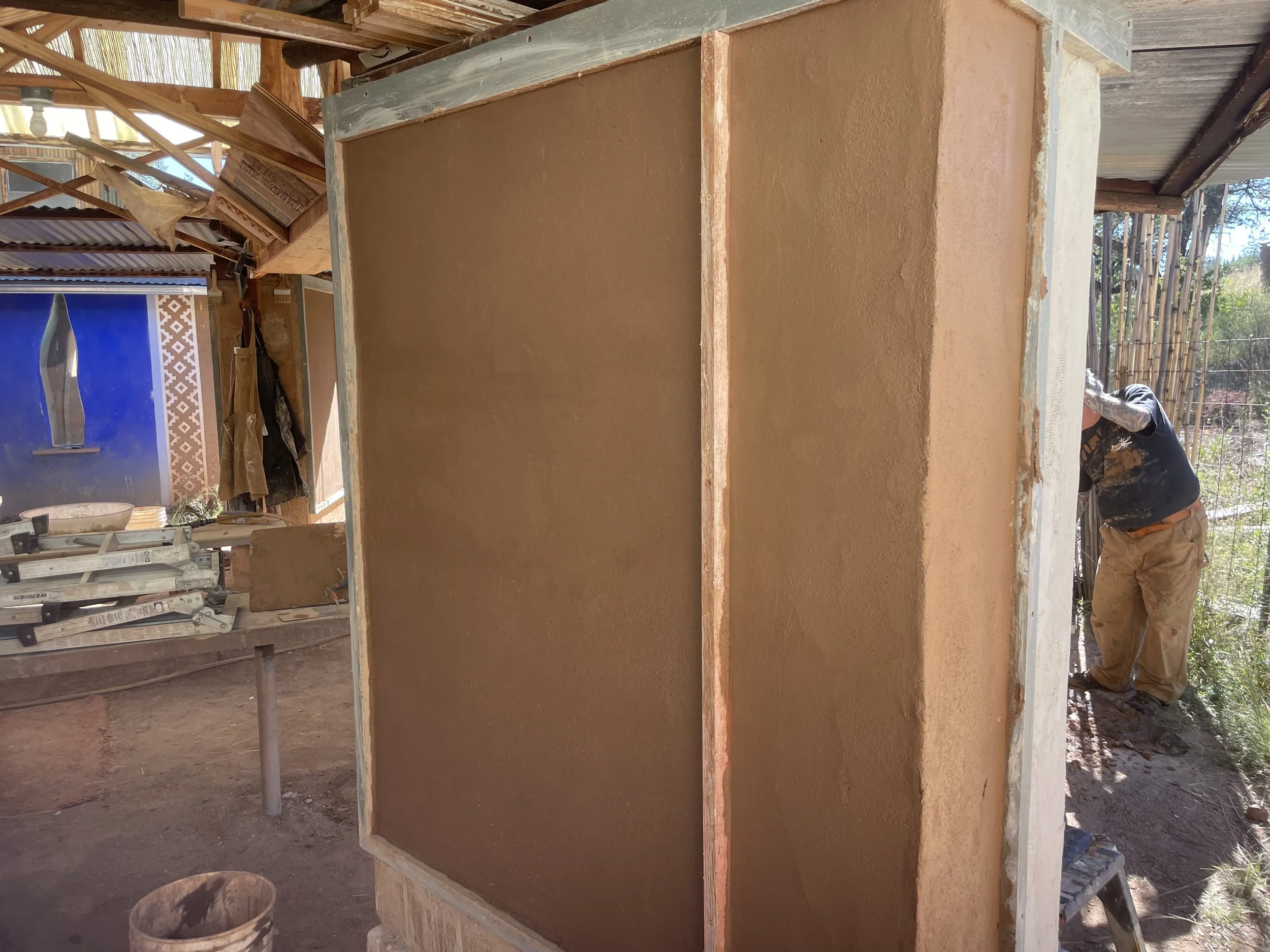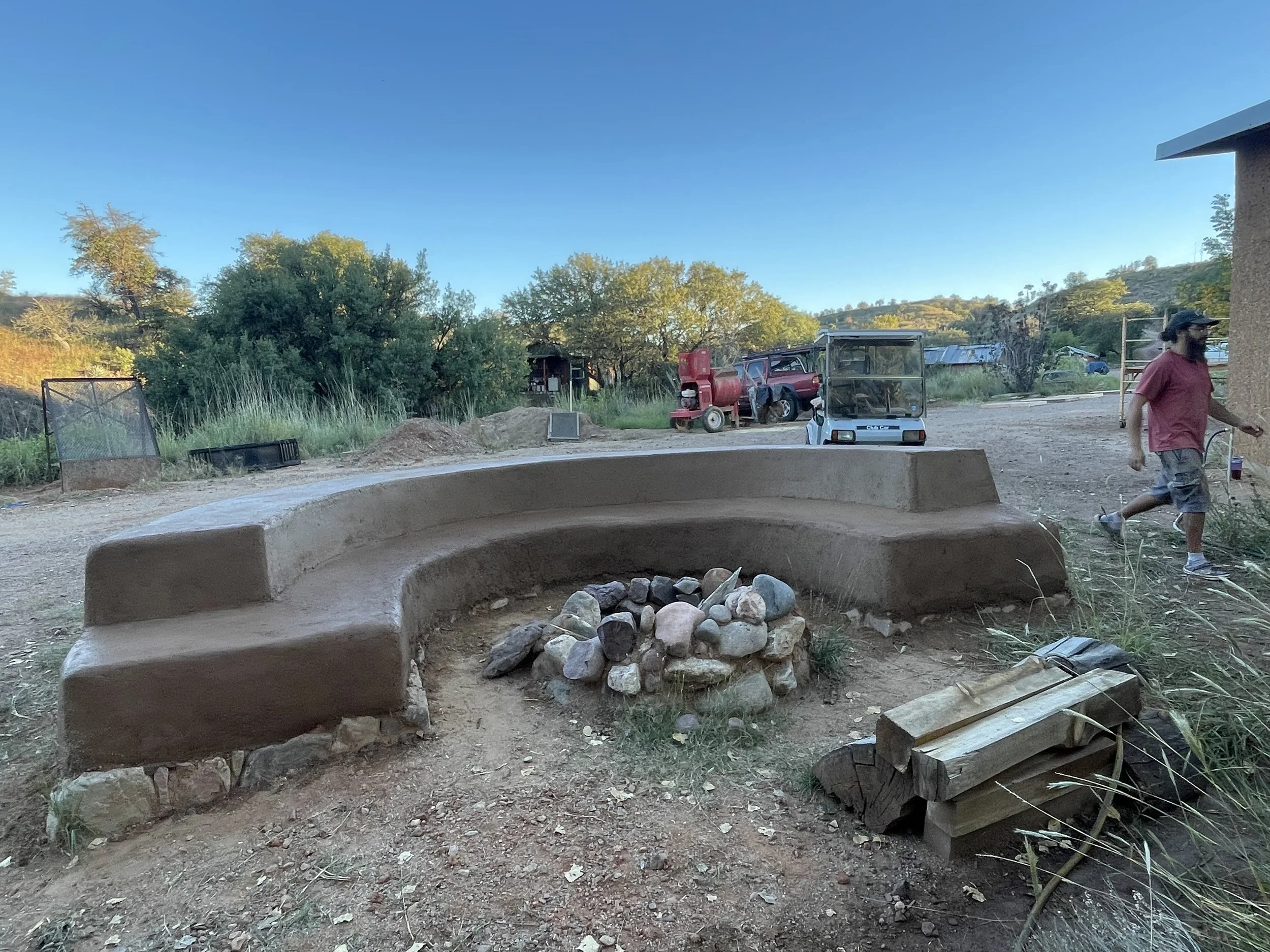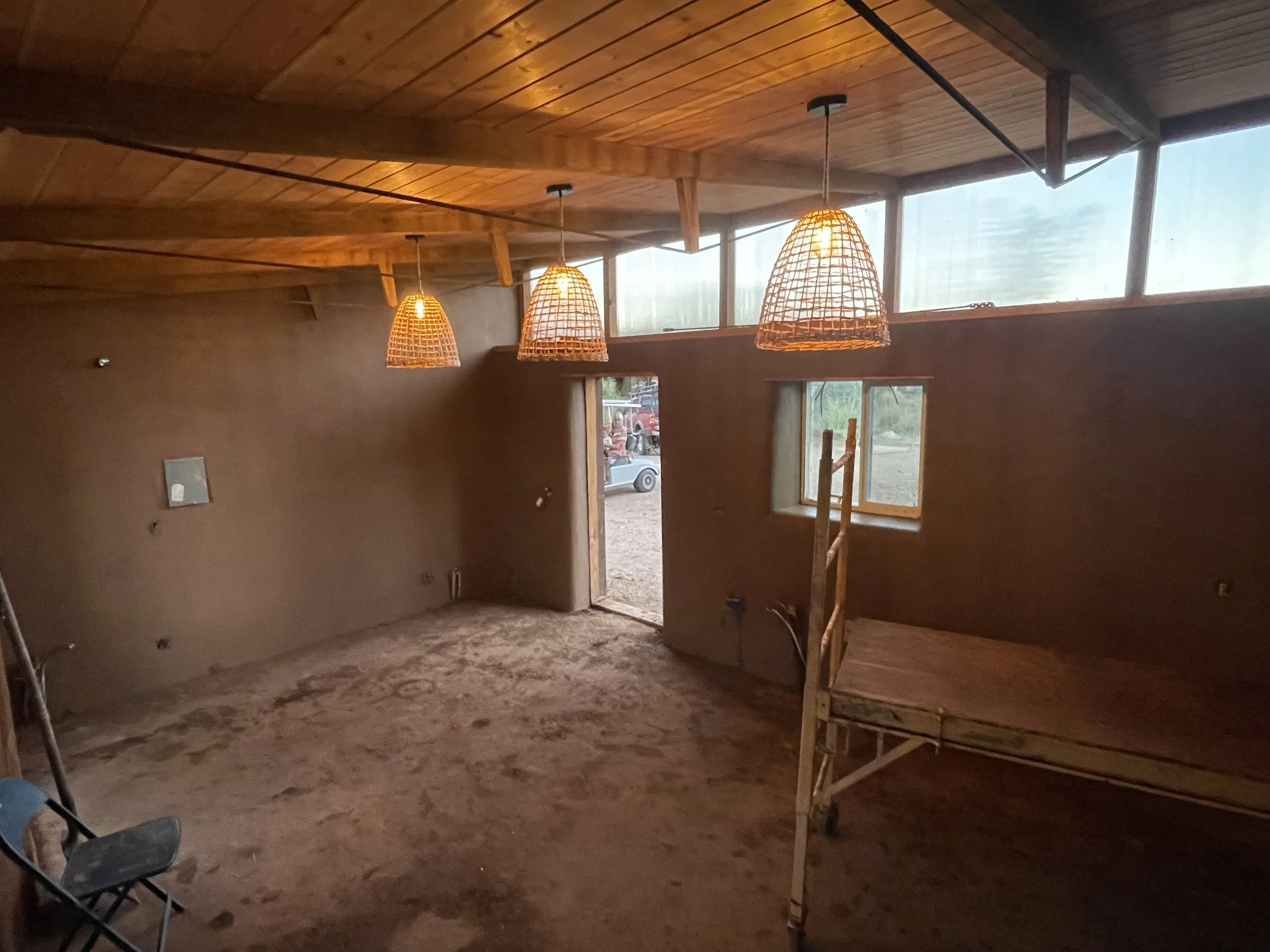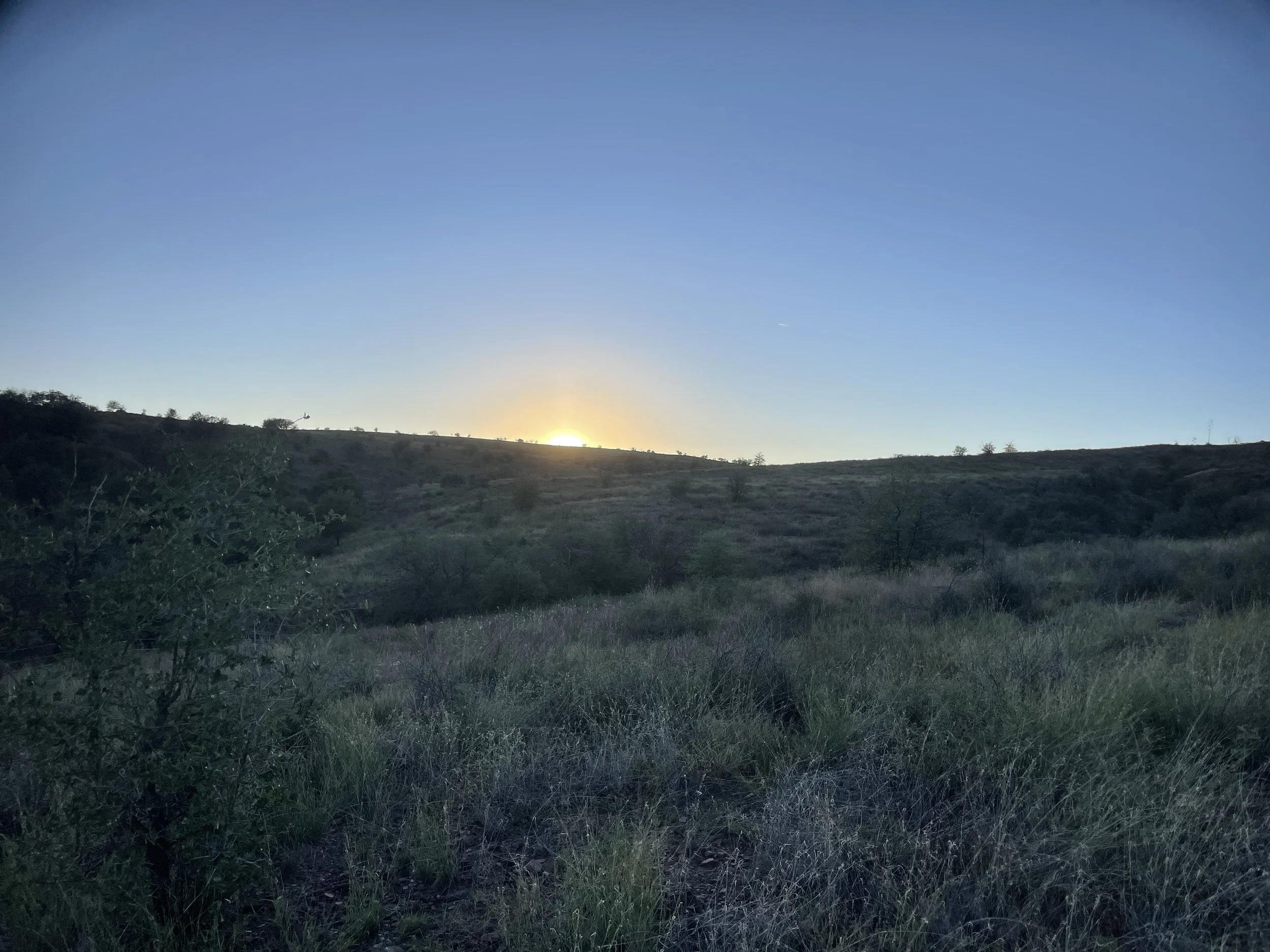The Canelo Project
10/23/2025-10/28/2025
Early in the morning on 10/23/25, Crawdaddy and I embarked on a sojourn to learn about Natural Plasters and Earthen Floors in Canelo, Arizona with the Canelo Project. This would be my 2nd trip out there this year, as I felt called to go to a Timber Framing workshop with the Canelo Crew over my birthday weekend in Mid April. For that workshop building a frame for their bath house using ancient french scribing techniques to join irregular forms together with mortise and tenon joinery. The experience left me craving a deeper understanding of earthen building and more connection with such incredible people.
The bathhouse frame we built during the April 2025 with Adam Miller’s workshop.
As fate would have it, my search into their offerings found a plastering workshop was being offered over E’s birthday weekend. I found the symmetry of the birthday trips beautiful and felt it was important to see the Steen Family sling mud, as this and straw bale construction (which I hope to return for next spring) are what made them famous. I booked the trip, and invited my good friend Evan Crawford, (aka Crawdaddy/Sgt. Crawford) to join, knowing he would find the experience as transformative as I did, he thankfully agreed.
To fully comprehend the beauty and grace of their place one must go there, however, their website, caneloproject.com , does a damn good job of getting close. The photography and videography alone inspires me to seek get outside and build something special, but the lessons learned in that little cottonwood valley were of compassionate patience with myself, because expertise and transformation take lots of time, effort, and trial and error.
“Nothing important comes into being overnight; even grapes and figs need time to ripen. If you say that you want a fig now, I will tell you to be patient. First, you must allow the tree to flower, then put forth fruit; then you have to wait until the fruit is ripe. So if the fruit of a fig tree is not brought to maturity instantly or in an hour, how do you expect the human mind to come to fruition, so quickly and easily?” -Epictetus
Day One always begins with a settle in period, a beautiful meal, and an orientation in the main house. The way Bill and Athena open up their home to strangers and welcome them with warmth and gratitude is remarkable.
Overlooking the open two tiered living space is a towering bookshelf loaded with books on all things related to earthen building and design. Straw bale building, feng shui, adobe, cob, rammed earth, homesteading, gardening, philosophy, design, permaculture, photography, thatch roofing, and so much more. Bill told me later in the week that the Canelo Project emerged from every one of those books, maybe just a sentence or an idea, but each one contributed in a meaningful way.
After introductions were completed and everyone was getting ready to go to bed, Bill chimed in as he does saying, “Whatever happens tomorrow, don’t get frustrated with the clay.” After hearing this I smiled self assuredly thinking “I can sling mud, I’ve got nothing to worry about”….per usual I was about to be served some humble pie, cold.
Day 2 Crawdaddy and I made our way to the Dojo which is an ovular arrangement of a dozen or so panels to practice applying the plaster to a wall with four corners and a three dimensional corner. This would be our arena to work from, our job was to use this panel as a space to recreate the techniques shown to us by Benito.
Benito, Bill and Athena’s oldest son, was leading the workshop and showed us how to a mix the clay, prep our panels, and work with our trowels and hawk. Given I have logged countless hours finishing drywall I thought I would be able to manage my material with grace, this was not the case.
Benito showing us how to properly get material off of the hawk, onto the trowel, and eventually onto the wall.
Their techniques were from the traditional plastering trade, which means they are throwing up high volumes of material with speed, consistency, and minimal effort. Immediately Crawdaddy and I were covered in mud droppings with panels that looked like a skip trowel finish no one asked for.
While we are wrestling the mud Benito was making the rounds. For context, Benito is like a modern day Michelangelo, but he would never boast or brag, he simply allows his work to do the talking. Check out his work on YouTube, his channel is called TheNitoProject https://www.youtube.com/@TheNitoProject .
Benito would make the rounds to our spots, (Crawdaddy and I shared a bay), and when he arrived at ours a silence would fall over our work as the muddy professor took in our chaos, following the silence would be a gentle tone of encouragement and some pointers to improve upon, always leaving us feeling chagrined and humbled in the best way possible.
Then Athena (the matriarch) would come by, and she is a little more intense and direct with her feedback and admonishment, and interestingly, without fail would leave us with a completely different set of strategies to try to reach the objective that was to load the panel for the base coat in a perfectly level manner.
The take away message was this is way harder than it looks and it takes a long time to and continual experimentation reach a place of competency. Sure enough I found myself in a place of frustration despite Bill’s warning, because I was trying too hard. With plaster there is an element of overthinking that can inhibit progress. I am reminded of a book of matches on Erin’s alter with Bruce Lee that say “Don’t Think, Just Feel”.
And so it goes.
Benito’s Panel…
The next few days followed a similar arc as we progressed through our coating layers and experimented with Lime Plaster finishes. Benito is an excellent teacher and surprisingly well versed in chemistry. He would take us through the chemical make ups of each compound and how they react with each other to produce certain effects. It’s fascinating how far you can go with plaster specifically, but also the world of natural building.
My panel on Day 3 or so, you can see how the outside corners present a whole new level of difficulty.
In order to shake up the activities and our spirits we transitioned to some floor samples. When making a floor mixture you want a ratio with a higher aggregate (sand) than bounder (clay). In our group we made a mix with 1 part clay 3 parts sand and water. That’s it. Of course we mixed it, applied it, leveled it, tamped it, and let it dry, but the process was equal parts simple and profound. Once dry, a finish could be applied with a boiled linseed oil or tung oil or even a traditional sealer. It’s fun to be in a place where having a dirt floor is encouraged.
As the long weekend winded down the desert sun began to take a toll on we easterners. The coup de gra was for the squad to apply their new found aptitudes onto one of the structures, the walls of their new kitchen house. It felt good to be out of the corral and into the show pen.
Where we again found ourselves covered in mud overthinking the process.
Oso, the 2nd brother came through and asked if he could help. He showed us the priniciple of “More on, Morons”, (this was my term not his :), but it was rooted in get the mud on the wall and allow the Darby and the floats to shave it down to level after the material is on the wall.
This advice brought a levity to the situation and after a little mud is on the wall it sticks far easier than it does on the initial pass. Applying the mud and having it remain in place brought both Crawdaddy a bit of an “aha” moment that yielded some confidence and energy.
It’s easy to get a attached to your own section, but the beauty of the moment came to light when I took a step back and saw over 20 plus people working together for one common goal, smiling and laughing as they worked and supported each other’s quest for improvement. I return coating two beautiful walls and a curving two tiered straw bale bench around a fire pit, forming a Kiva.
A kiva was a sacred space used by Puebloans for rites and political meetings. More modern interpretations apply it to circular spaces for ceremony and places of worship. Athena’s mother was Pueblo and thus the family has deep roots in the ways of working with clay. Checkout Rooted In Clay on YouTube, https://www.youtube.com/watch?v=wGhnkAJAdWU It’s her life-story of her experience with clay and natural building.
As the kitchen walls began to fill, people began shifting their focus to leaving, cleaning, and smoothing. One by one the people left the space clearing the way for the maestro to refine the work. Benito seemed to shape shift in front of our eyes. The teacher and foreman stepped aside to allow the artist to work. Beveling windows, leveling high spots, cleaning transitions, tightening the cuts around outlets and panels, all with speed and grace. He would chat occasionally, but it was clear he was focused on finishing it to his standard with what remained of the waning afternoon light. Soon a small audience gathered of family to chat and celebrate a job well done, but Benito continued to work, taking it to a higher place.
So there we sat, watching the young master in his element. Inspired, exhausted, and thoroughly impressed we stepped outside and made our way back to the main house to clean up and enjoy our last supper together.
Sunset over Canelo



